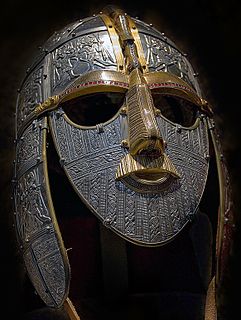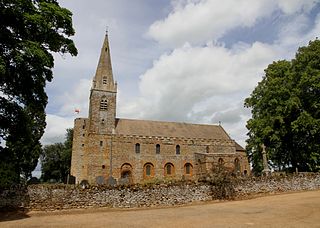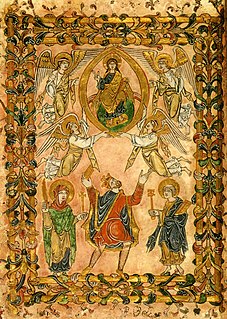 W
WIn the seventh century the pagan Anglo-Saxons were converted to Christianity mainly by missionaries sent from Rome. Irish missionaries from Iona, who were proponents of Insular Christianity, were influential in the conversion of Northumbria, but after the Synod of Whitby in 664 the English church gave its allegiance to the Pope.
 W
WAnglo-Saxon missionaries were instrumental in the spread of Christianity in the Frankish Empire during the 8th century, continuing the work of Hiberno-Scottish missionaries which had been spreading Celtic Christianity across the Frankish Empire as well as in Scotland and Anglo-Saxon England itself during the 6th century. Both Ecgberht of Ripon and Ecgbert of York were instrumental in the Anglo-Saxon mission. The first organized the early missionary efforts of Wihtberht, Willibrord, and others; while many of the later missioners made their early studies at York.
 W
WAnglo-Saxon religion may refer to several distinct periods, events and types of religion in the British Isles:the pre-Christian Anglo-Saxon polytheism the Christianization of the Anglo-Saxons by Germanic Christianity and the Anglo-Saxon mission Anglo-Saxon Christianity the post-reformation Anglican Church or Presbyterianism the Neopagan Theodism
 W
WThe Bewcastle Cross is an Anglo-Saxon cross which is still in its original position within the churchyard of St Cuthbert's church at Bewcastle, in the English county of Cumbria. The cross, which probably dates from the 7th or early 8th century, features reliefs and inscriptions in the runic alphabet. The head of the cross is missing but the remains are 14.5 feet high, and almost square in section 22 x 21 1/4 inches at the base. The crosses of Bewcastle and Ruthwell have been described by the scholar Nikolaus Pevsner as "the greatest achievement of their date in the whole of Europe".
 W
WAll Saints' Church, Brixworth, now the parish church of Brixworth, Northamptonshire, England, is a leading example of early Anglo-Saxon architecture. In 1930 the British architectural historian Sir Alfred Clapham called it "perhaps the most imposing architectural memorial of the 7th century yet surviving north of the Alps". It is the largest English church that remains substantially as it was in the Anglo-Saxon era. It was designated as a Grade I listed building in 1954.
 W
WThe so-called Claudius Pontificals are the texts in British Library, Cotton Claudius A.iii, a composite manuscript of three separate pontificals, i.e. compilations of the services reserved for bishops, especially the coronation of kings. The first two date to the 11th century, the third to the 12th century.foll. 4-6, formerly bound with the Coronation Gospels, contain the "Æthelred confirmation" and the "Edward the Confessor confirmation". Claudius Pontifical I, foll. 31-86, 106-150 ; this early 11th-century book was owned by Wulfstan ; on fol. 31 a commemorative verse in Old English, informing us that this halungboc was bound at the expense of one Thureth, presumably a Northumbrian earl; Claudius Pontifical II, foll. 9-18, 87-105, mid 11th century, contains the Second Anglo-Saxon Ordo; Claudius Pontifical III, foll. 19-29, consists of the Third English Coronation Order, early to mid 12th century.
 W
WWhat is usually referred to as St Cuthbert's coffin is a fragmentary oak coffin in Durham Cathedral, pieced together in the 20th century, which between AD 698 and 1827 contained the remains of Saint Cuthbert, who died in 687. In fact when Cuthbert's remains were yet again reburied in 1827 in a new coffin, some 6,000 pieces of up to four previous layers of coffin were left in the burial, and then finally removed in 1899. This coffin is thought to be Cuthbert's first wooden coffin, and probably to date to 698, when his remains were moved from a stone sarcophagus in the abbey church at Lindisfarne to the main altar.
 W
WThe English Benedictine Reform or Monastic Reform of the English church in the late tenth century was a religious and intellectual movement in the later Anglo-Saxon period. In the mid-tenth century almost all monasteries were staffed by secular clergy, who were often married. The reformers sought to replace them with celibate contemplative monks following the Rule of Saint Benedict. The movement was inspired by Continental monastic reforms, and the leading figures were Dunstan, Archbishop of Canterbury, Æthelwold, Bishop of Winchester, and Oswald, Archbishop of York.
 W
WThe Council of Hertford was the first general council of the Anglo-Saxon Church. It was convened in Anglo-Saxon Herutford, most likely modern Hertford, in 672 by Theodore of Tarsus, Archbishop of Canterbury. The Venerable Bede is the historical source for this council, as he included its text in his Ecclesiastical History of the English People.
 W
WInsular art, also known as Hiberno-Saxon art, was produced in the post-Roman history of Ireland and Britain. The term derives from insula, the Latin term for "island"; in this period Britain and Ireland shared a largely common style different from that of the rest of Europe. Art historians usually group insular art as part of the Migration Period art movement as well as Early Medieval Western art, and it is the combination of these two traditions that gives the style its special character.
 W
WJordan of Bristol was a saint venerated in Bristol, England, before the Reformation, about whom little is known with certainty.
 W
WThe Leeds cross is a collection of fragments of probably tenth-century stone sculpture that has been reassembled into a cross. The fragments were found in the fabric of Leeds Parish Church when the tower of the old church was demolished in 1838. The architect, Robert Chantrell noticed a collection of carved stones built into the medieval architecture, some of them forming the cross. Representations of the four Evangelists appear between distinctive interlaced decoration dating to the 10th or 11th centuries. The cross currently stands within the church and is an important example of Anglo-Saxon sculpture. It is also the most complete example of a number of depictions of the legendary smith Weland and Beaduhild, the mother of his child, from tenth-century Yorkshire.
 W
WThroughout its history the Kingdom of Mercia was a battleground between conflicting religious ideologies.
 W
WRicheldis de Faverches, also known as "Rychold", was a devout English noblewoman who is credited with establishing the original shrine of Our Lady of Walsingham. The story of the vision of "Rychold" was recounted in the 15th century in "The Foundation of the Chapel of Walsingham", published by Richard Pynson. The reputed appearance of the Virgin Mary to Richeldis is one of the earliest Marian apparitions.
 W
WStow Fair was an English medieval fair inaugurated in 1233. The Prior of Sempringham was granted permission in 1268 to hold this annual fair, from 23 to 25 June, confirming an earlier charter. The fair continued until living memory, being run as a horse fair until 1954.
 W
WThe Vita Sancti Wilfrithi or Life of St Wilfrid is an early 8th-century hagiographic text recounting the life of the Northumbrian bishop, Wilfrid. Although a hagiography, it has few miracles, while its main concerns are with the politics of the Northumbrian church and the history of the monasteries of Ripon and Hexham. It is one of a collection of historical sources from the late 7th- and early 8th-centuries, along with the anonymous Vita Sancti Cuthberti, the works of Bede and Adomnán's Vita Sancti Columbae, that detail the Christianisation of Great Britain and make the period the best documented period in English history before the age of Alfred the Great.
 W
WThe Abbey Church of Waltham Holy Cross and St Lawrence is the parish church of the town of Waltham Abbey, Essex, England. It has been a place of worship since the 7th century. The present building dates mainly from the early 12th century and is an example of Norman architecture. To the east of the existing church are traces of an enormous eastward enlargement of the building, begun following the re-foundation of the abbey in 1177. In the Late Middle Ages, Waltham was one of the largest church buildings in England and a major site of pilgrimage; in 1540 it was the last religious community to be closed during the Dissolution of the Monasteries. It is still an active parish church for the town.